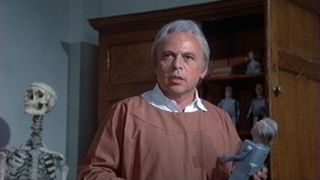Asylum
1972 UK
Dir:Roy Ward Baker
Stars:Peter Cushing, Britt Ekland, Charlotte Rampling, Herbert Lom
Above:Herbert Lom
"Asylum" is a kind of horror movie with black humor whose story is composed of several individual
parts, and each of these parts is in turn loosely coupled by, and integrated into, a kind of meta-story. I think
essentially this movie is quite excellent except just one point; that is, the last scene. I have a far better idea
with regard to this last scene than what is actually presented here. I guess you must have at least one or two
such movies, movies on some part of which you have a better idea, and, in the same manner, this movie is such a
one for me. The stage is set in some mental hospital, i.e., an asylum as the title suggests, and each one of four
patients locked up in this asylum tells a newly appointed doctor (Robert Powell) a strange story, and these four
stories are in turn incorporated into a meta-story; a story that the newly appointed doctor's ability to handle
serious mental cases is tested by the chief doctor (Patric Magee). The reason why I've said the last scene of this
movie isn't good is because despite the fact that all those stories told by the mental patients are quite fantastic
and, at the same time, very very peculiar and weird, the last scene turns in the result these fascinating stories
into just a bunch of occult monster stories. As I can easily expect those who have never watched this movie surely
wouldn't understand what I'm saying, here I explain it briefly. The stories told by the patients are, as I said
before, quite weird such as each body part of a corpse dismembered (Sylvia Syms) suddenly getting in motion and
harassing a girl (Barbara Parkins) who is an accomplice of her murderer, i.e., the victim's husband (Richard Todd),
and such as a mini-size doll made by a patient (Harbert Lom) as looking alike to him moving around the hospital
being assisted by some kind of psycho-power remotely exerted by the patient himself and stabbing the chief doctor
to death with a needle. In short, these stories are unable to happen in real life. But, even so, these preternatural
stories alone couldn't have degraded the movie to just another example of a bizarre occult movie if the last scene
hadn't been in the way actually presented here. Because there is a premise that the patients who are telling all
those stories are insane. Yet the last scene where the newly appointed doctor is killed by another minor doctor
makes this premise useless. For, there is an unalterable fact that the doctor finally thus killed saw the aforementioned
scene where the chief doctor was killed by a doll operated by a patient played by Herbert Lom, and furthermore
the fact that he is finally killed surely proves the point that he wasn't insane (although you might say just being
killed never endorse that he wasn't insane, it should be well considered that even if it's true in real life, it
isn't necessarily so if told in a story because there is a general rule that if, in a story, someone is killed
without any signs of madness having been shown prior to his death, it should be so considered that there is no
reason whatsoever that he should have been considered insane). Saying briefly, the fact that a not-insane normal
doctor also saw the same unnatural scene that one of the patients saw completely changes the meaning of the whole
story in such a way as, after all, those stories aren't just delusions seen by mental patients. What I want to
say here is that it could have been far better had the doctor himself, by whose perspective the meta-story part
is told, been a mentally affected person too, and furthermore, the structure "delusion in delusion" brought
about by this idea would have further deepened the meaning layer of this movie perfectly fitting to such overall
scheme that four individual parts are integrated into a meta-story. Incidentally, similar kind of British movie
"Tales that Witness Madness"(1973) directed by Freddie Francis who is the specialist of this type of
movies seems to have tried to correct this deficiency in the same way as I've just suggested. But as this movie's
individual stories aren't as good as the ones of "Asylum", the overall quality is far inferior to it.
After having told all of this, still I can recommend "Asylum" strongly. Because all those individual
stories are told quite imaginatively, and even have black humor such that the head of the aforementioned dismembered
body covered with a paper bag is pulsating quite grotesquely around the mouth everytime it inhales and exhales
the air. I think British people are very very adept at this kind of weird black humor, and we can surely witness
it in this movie. Besides, the cast is gorgeous as this kind of horror movie, which include Richard Todd, Barbara
Perkins, and Sylvia Syms in the first story, and Peter Cushing and Barry Morse in the second one, and Charlotte
Rampling and Britt Ekland in the third one, and Herbert Lom in the fourth one, and Robert Powell and Patric Magee
in the meta-story. I guess if the last scene had been handled in a more proper way, this one might have been a
masterpiece of its genre.

